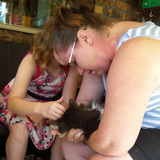When it is time to say goodbye, Euthanasia gently and compassionate October 9, 2017 16:08
It’s such a hard topic to talk about. Pets that are unwell or elderly, and need a little help to pass away without pain. But today I am going to “go there” because I think it’s important to be informed. Euthanasia is the correct term for “putting a pet to sleep”. No matter which vet you see, it is almost certain that we use the same drug – Lethobarb.
It is a green coloured solution that needs to be injected into a vein, and its results are very rapid.
doesn’t cause pain, and the pet is anaesthetised at the time of death so there is no consciousness or fight for survival.
What does differ more markedly between vets is how we handle the pet prior to injecting the Lethobarb. I personally choose to sedate pets first.
A small injection under the skin allows them to drift off slowly into a very sleepy relaxed state, which means that I don’t need to restrain them to be able to access a vein for the final injection.
I hate the idea of fear, struggle or trauma in a loved pets final moments, so I take this step to ensure the most peaceful experience possible.
Because I am a mobile vet, I do more than my fair share of euthanasias. People seek me out to allow their frail elderly or terminally ill pets to pass away peacefully
in the familiar and comfortable surroundings of their own home.

One of the most difficult parts of an extremely emotional experience is deciding when it is the right time for your pet.
Some people have told me that the decision making process over weeks or months of up-and-down gradually declining health is more emotionally draining than actually saying goodbye.
It can be really helpful to have a vet consult purely to assess your pets quality of life, and discuss whether or not it is time to let them go with someone outside of the family who can be objective about whether your pet is suffering.
The other part of the process is deciding what you would like to happen to your pets remains. Again it’s a really confronting topic, but for every pet that passes away the decision has to be made.
In general there are three options.
Firstly burial. You may need to check with your local council regulations first. If it is allowed in your area and you would like to bury your pet, you need to
dig a deep grave. There needs to be at least 3 - 4 foot of solid earth above a buried pet, to protect native and nocturnal animal from coming into contact with
the drugs that will remain in their bodies for a long time.
Secondly individual cremation. There are companies that do this really well. They will collect your pet after he or she is euthanased, cremate them with care
and return their ashes to you in an urn or scatterbox, often with a plaque, a photo, a paw print or locks of hair. At time of writing the cost for this service
starts at approximately $300 for dogs and cats.
And the third option is non individual cremation. For my clients that choose this option, I will take the remains with me and organise this for them.
They are cremated in similar facilities to the previous option, and you will not receive any ashes or keepsakes in return. However you can be at peace knowing
that their remains will have been given respect and dignity.  And finally, a few words about the grieving process.
And finally, a few words about the grieving process.
It has been shown that the grieving process has certain well recognised stages, and that people move through
some or all of them at different paces. This is true for loss of a loved person as well as for loved pets. I personally was shocked at the intensity of my grieving for quite a while after we lost little Lara. For remaining pets, keep their daily routine as unchanged as possible and ensure that they have plenty of exercise.
For people, don’t fight the emotions. Allow yourself to feel and acknowledge your loss, so that you can begin the healing process. If you aren’t progressing along that path, then seeking advice from a trained counsellor or psychologist will probably be beneficial. There is no harm in admitting it hurts, you are mourning the loss of a family member.
If you would like more information about this topic or need to communicate with me about your individual needs then I would be happy to help. Sometimes
emailing is easier because I have found that most people have difficulty maintaining their composure sufficiently on the phone once we are actually talking about
the procedure. People often ask me how I can do it, and comment that it must be a really difficult housecall to make. I actually am really honoured to be able to be present and to think that I can help make such an intense and difficult time a little more peaceful for both pets and their families
.
